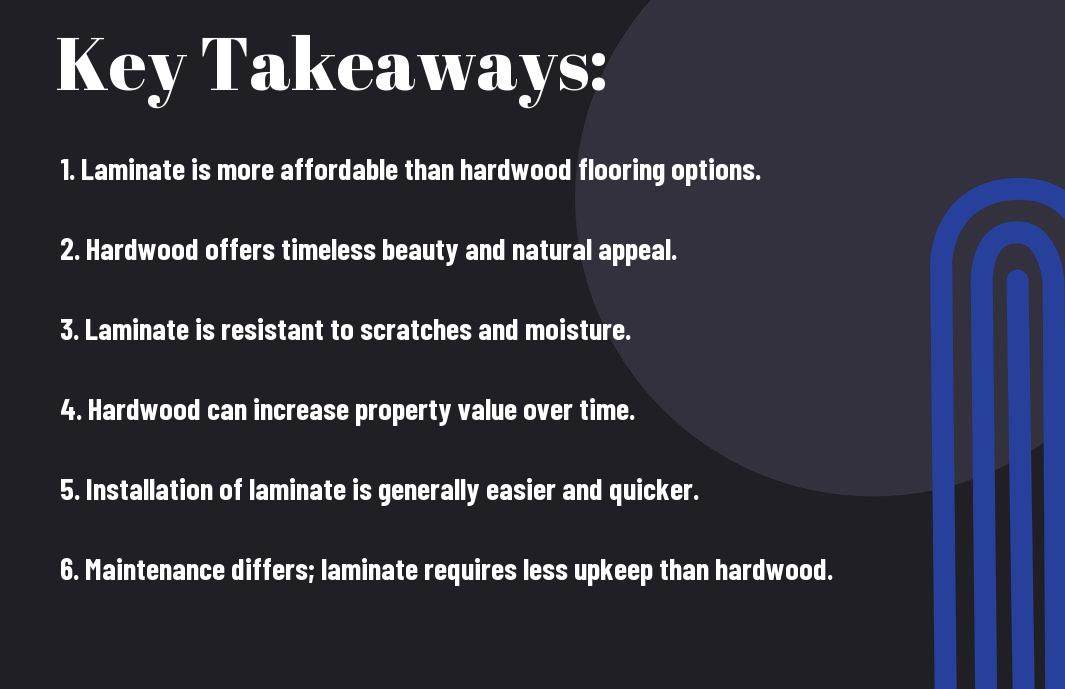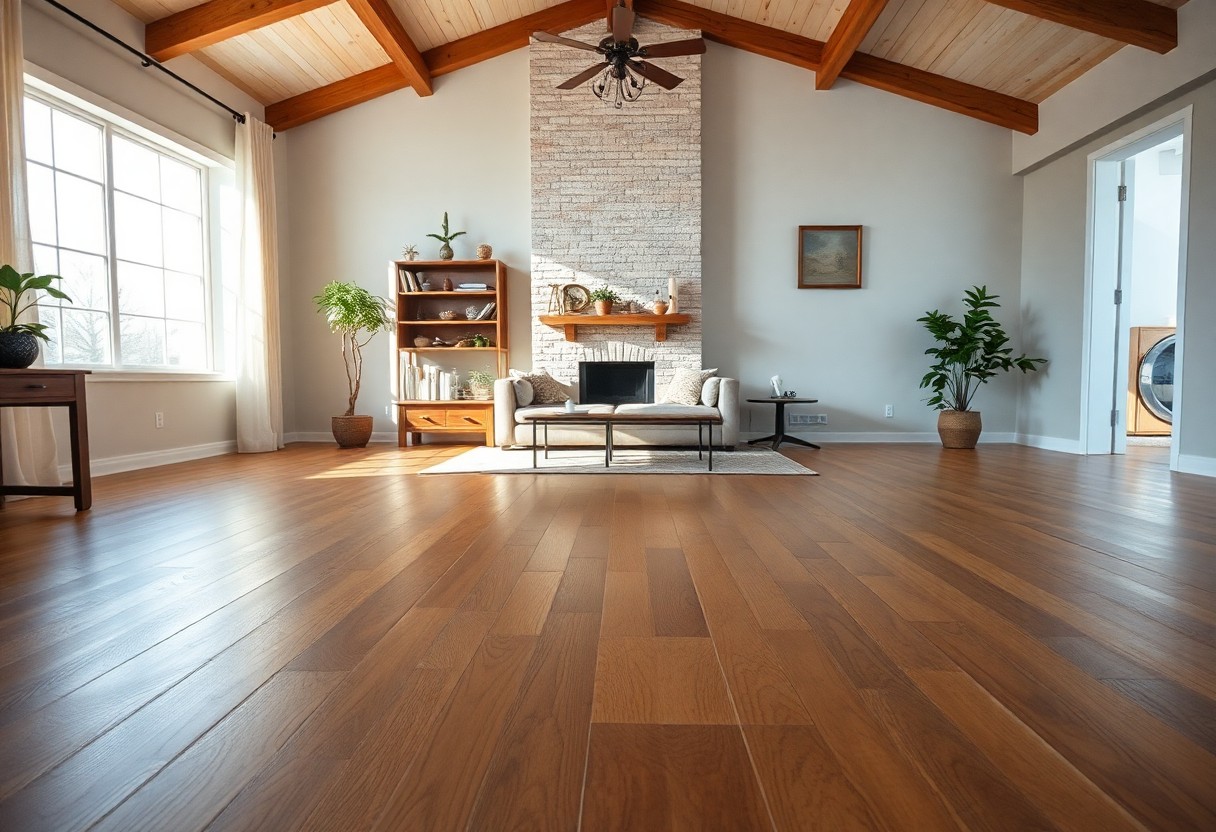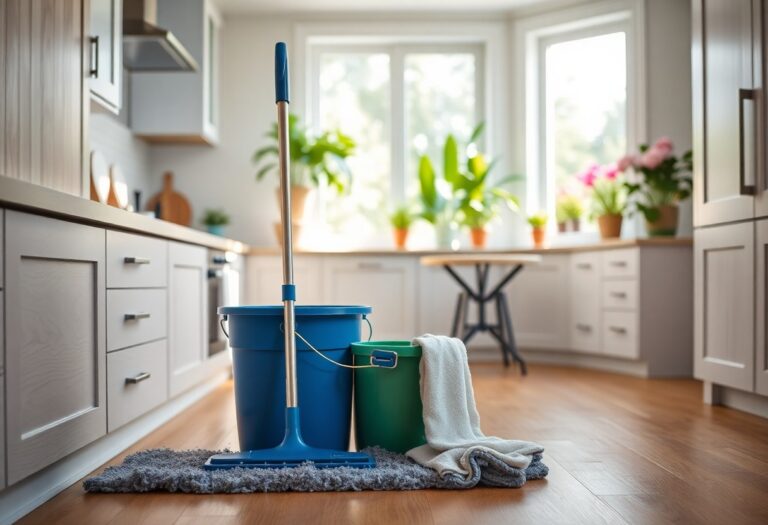You may be considering new flooring options for your home, and it’s necessary to weigh the differences between laminate flooring and hardwood. Each has its unique benefits and drawbacks, from durability and cost to maintenance requirements and aesthetic appeal. Understanding these factors will help you make a well-informed choice that fits your lifestyle and budget. In this article, you’ll discover everything you need to know to decide which flooring option is the best fit for your needs.

Key Takeaways:
- Cost: Laminate flooring typically offers a more budget-friendly option compared to high-quality hardwood flooring.
- Durability: Laminate is generally more resistant to scratches and wear, making it suitable for high-traffic areas, while hardwood can be prone to damage over time.
- Aesthetics: Hardwood provides a natural and timeless beauty that many homeowners love, whereas laminate can mimic the appearance of wood but may lack the depth and authenticity.
Overview of Flooring Types
Before exploring into the intricacies of laminate and hardwood, it’s important to have a solid understanding of both types of flooring. Whether you are renovating your home or simply updating a space, knowing the options available can help you make better decisions tailored to your lifestyle and preferences. Here’s a brief overview of what each flooring type entails:
- Laminate Flooring: A manufactured flooring product designed to mimic the appearance of wood.
- Hardwood Flooring: Made from solid wood or engineered wood, offering a natural, elegant look.
- Durability: Laminate is generally more resistant to scratches and moisture than hardwood.
- Installation: Laminate can be easier to install than hardwood, often featuring a click-lock design.
- Cost: Laminate typically costs less than hardwood, making it a more budget-friendly option.
Thou, by understanding these key differences, you can better navigate your flooring choices.
| Flooring Type | Description |
|---|---|
| Laminate Flooring | A synthetic product made from composite materials to replicate the look of wood. |
| Hardwood Flooring | Made from real wood, offering a classic and timeless appearance. |
| Durability | Laminate is often more resistant to wear and damage compared to hardwood. |
| Installation | Laminate can usually be installed more easily than hardwood, especially for DIYers. |
| Cost | Laminate is generally more affordable than hardwood options. |
Definition of Laminate Flooring
Behind the glossy surface that resembles natural wood lies the technology and innovation that define laminate flooring. This type of flooring is a fusion of various materials, primarily particleboard, fiberboard, and a decorative layer topped with a protective coating. The layering process creates a durable and attractive alternative that can simulate the look and feel of real wood. This is achieved through advanced printing techniques that capture the texture and intricate details that you would typically find in hardwood.
One significant advantage of laminate flooring is its resistance to wear and tear, making it an excellent choice for high-traffic areas, such as living rooms and hallways. The protective layer above the decorative layer provides a formidable barrier against scratches and stains, extending the life of your flooring. Put simply, laminate flooring provides a lower-maintenance solution while offering aesthetic appeal. Cleaning it is a breeze, requiring only a damp cloth or occasional sweeping to maintain its look.
Moreover, laminate flooring is available in a wide array of designs, colors, and textures. This flexibility enables you to tailor your choice to fit any interior design scheme, from rustic to modern. Whether you are seeking a light oak shade or a darker mahogany finish, there’s likely a laminate style that matches your vision. Choosing laminate might also provide your home with a cozy feel without breaking the bank, allowing you to enjoy the beauty of wood aesthetics wherever you desire.
Definition of Hardwood Flooring
On the other hand, hardwood flooring epitomizes elegance and luxury, with each plank telling its own unique story. Comprised entirely of solid wood or engineered wood, hardwood flooring provides unmatched beauty and longevity that many homeowners crave. Its aesthetic appeal is timeless, making it a preferred choice for both residential and commercial applications. When you select hardwood, you are choosing a product that can elevate your space, giving it an upscale feel.
One of the defining characteristics of hardwood flooring is its sustainability. Many species of hardwood come from responsibly managed forests, and whenever you install hardwood flooring, you contribute to a more eco-friendly environment. Additionally, the natural properties of wood allow for better insulation, enhancing the temperature control in your home. Unlike laminate, hardwood can also be refinished multiple times, restoring its original glory and prolonging its lifespan.
Furthermore, when it comes to resale value, hardwood flooring significantly boosts your home’s market appeal. Its classic look tends to attract a broad pool of potential buyers, allowing you to recoup much of your investment when you sell. Statistically, homes with hardwood floors sell faster than those with other types of flooring. Hence, should you choose hardwood, you are likely making a sound investment in the future of your home.
Common Uses and Applications
Commonly, you will find laminate flooring and hardwood flooring being employed in various spaces, each suited to the flooring type’s individual strengths. Laminate is particularly popular in homes with children or pets, as its durability and scratch resistance make it ideal for play areas and high-traffic zones. Similarly, commercial properties often utilize laminate due to its cost-effectiveness and ease of maintenance, making it suitable for offices or retail spaces.
Hardwood flooring, on the other hand, is frequently chosen for its timeless beauty in formal living areas, dining rooms, and bedrooms. Its natural warmth creates an inviting atmosphere while exuding sophistication. Whether you’re considering a classic oak for your dining room or a unique walnut for your study, hardwood can enhance the aesthetics and resale value of your home.
Flooring in your home plays a significant role in defining its overall character. Each type serves its purpose and offers benefits tailored to specific needs, from the robust nature of laminate to the rich elegance of hardwood. With both flooring options available, you’ll find a perfect match for your space, lifestyle, and aesthetic goals.

Aesthetic Considerations
Clearly, when evaluating laminate flooring and hardwood, one of the most striking elements to consider is their visual appearance. Both flooring options offer distinct advantages in this category, and your choice ultimately depends on the overall look and feel you aim to achieve in your space. Laminate flooring is designed to mimic the natural beauty of hardwood, often featuring photorealistic images of wood grain and textures. The benefit here is that you can achieve a wood-like appearance without the hefty price tag that genuine hardwood may command.
Visual Appearance
Among the first things that may come to your mind when contemplating laminate flooring is its ability to replicate the warmth and charm of real wood. With advancements in technology, laminate can convincingly imitate different types of hardwood, from rich oaks to exotic teak. The result is a surface that maintains a natural look and can complement various design aesthetics—from modern to rustic. However, the texture and depth of real wood can be challenging for laminate to replicate fully, and you might find it lacks the same rich character and warmth that comes from authentic hardwood grains.
Additionally, while laminate flooring offers a sleek and polished finish, it may carry a more synthetic appearance than hardwood in certain lighting conditions. If you’re after a timeless and classic aesthetic, solid hardwood holds its ground with its unparalleled authenticity and elegance. It doesn’t just look beautiful; it develops character over time, showcasing unique imperfections and variations that many homeowners prize. In essence, the visual quality you desire will largely influence your decision, and both options come with their distinctive traits.
In the end, both laminate and hardwood can elevate the aesthetics of your home, but the differences in visual depth and character may lead you to a preferred choice that fits your personal style and preference for the natural world. Once you weigh the visual appeal of each option, the next category to consider is the array of styles and designs available within each type.
Variety in Styles and Designs
Behind the allure of laminate flooring is an expansive selection of styles and designs that might surprise you. From contemporary looks to traditional aesthetics, laminate has positioned itself as a versatile alternative capable of catering to almost every homeowner’s taste. You can find laminate options that feature finishes and stains synonymous with valuable hardwoods, allowing you to coordinate your flooring with your interior décor seamlessly. This wide assortment enables you to explore different themes and trends without the commitment that might come with selecting specific hardwood species.
Variety in style also extends to the room’s applications. For instance, if you are looking for flooring that can accommodate high-traffic areas or homes with pets, you have a plethora of laminate designs that cater specifically to those needs. Laminate options come with enhanced durability features, ensuring that you don’t have to compromise style for functionality. On the other hand, hardwood offers a limited selection based on the types of wood available, which could restrict your design possibilities. Depending on your vision, it is advantageous to consider how the color, grain, and finish of your flooring can harmonize with your living spaces.
Variety in styles and designs is critical in showcasing your unique personality through your home décor. Whether you opt for laminate or hardwood, you’ll find options that allow you to express your tastes while achieving a cohesive look throughout your residence.
Finishing Options
Below the surface, the finishing options available for laminate and hardwood can significantly impact their aesthetic appeal. Laminate flooring typically comes with a predefined finish designed to withstand heavy wear and tear while retaining its polished look. You will often find laminate available in a range of gloss levels—from high-gloss to more subdued satin finishes—allowing you to tailor your choice further based on your design vision. On the other hand, hardwood finishes can enhance its natural grain, emphasizing warmth and depth, and can be sanded and refinished multiple times, offering you long-term flexibility.
The finishing options available can also dictate the maintenance and longevity of your flooring choice. With laminate, while you benefit from a factory-finished product that offers ease of care, you might not have the same ability to change its finish over time. In contrast, with hardwood, the ability for refinishing affords you the opportunity to adapt the appearance of your flooring as your tastes or trends change, providing an ongoing value that complements your investment.
A simple change in finish or sheen can radically alter the look and ambiance of your space. Therefore, consider how each flooring type’s finishing options align with your long-term vision for your home, ultimately enhancing your aesthetic experience.

Durability and Maintenance
To understand the durability and maintenance needs of laminate flooring compared to hardwood, it’s vital to look into their expected lifespans. Both flooring options hold up well under various conditions, but their longevity can differ significantly based on the materials used and how they are cared for. An informed decision can help you choose the best option that aligns with your lifestyle and expectations.
Lifespan Comparison
Beside aesthetic differences, one of the major factors influencing your decision between laminate flooring and hardwood is their lifespan. Generally, hardwood floors boast a lifespan of 25 years or more when properly maintained. In contrast, laminate floors typically offer a durability of around 15 to 25 years. Factors such as climate and humidity, usage frequency, and maintenance routines can affect how long each type will last.
| Flooring Type | Estimated Lifespan |
|---|---|
| Laminate Flooring | 15 to 25 years |
| Hardwood Flooring | 25 years and beyond |
While hardwood flooring has a longer lifespan, it is also important to consider its potential for refinishing, which can extend its service life even further. In contrast, although laminate cannot be refinished, it is often designed to withstand wear and tear effectively. You should take into account your long-term plans for the space as you make your choice.
Resistance to Scratches and Dents
The ability of your flooring to resist scratches and dents is a significant consideration, especially in households with pets or high foot traffic. Laminate flooring often features a tough, wear-resistant layer that makes it suitable for busy environments. This protective layer can significantly reduce the chances of scratches and dents that can quickly mar the beauty of your floors. On the other hand, while hardwood flooring can withstand moderate impacts, it is more susceptible to scratches and dents, especially from heavy furniture or sharp objects, unless a strong finish is applied.
Additionally, you will need to evaluate the type of wood used for your hardwood flooring. Hardwoods like oak or hickory tend to be more resistant to damage than softer species like pine. Similarly, laminate flooring models are produced using a variety of materials, and you will want to select a product with a high AC rating for better scratch and dent resistance. Ultimately, your decision may hinge on your household’s specific needs, as well as whether you prioritize resilience or natural beauty.
Dents and scratches can be a homeowner’s nightmare, as they not only diminish the floor’s appearance but can also lead to further damage over time. In high-traffic areas, laminate flooring tends to outperform hardwood in this regard, offering a cost-effective option without sacrificing too much on visual appeal. The protective layer of laminate is designed to reduce the appearance of daily wear significantly.
Cleaning and Maintenance Requirements
An additional aspect to consider is the cleaning and maintenance requirements of laminate flooring versus hardwood. Laminate floors are generally easier to maintain since they only require regular sweeping and occasional damp mopping. Being moisture-resistant, they can be cleaned more thoroughly without risking water damage. In contrast, hardwood floors need to be cared for meticulously, as they can be sensitive to water and unsuitable cleaning products, which can damage the finish or warp the wood.
Moreover, hardwood flooring may require periodic refinishing to maintain its aesthetics and durability. This maintenance can be time-consuming and requires professional help, potentially increasing long-term costs. Laminate flooring, therefore, represents an attractive option for those who desire a beautiful floor without the extensive upkeep associated with hardwood. You should weigh your willingness to keep up with specific maintenance tasks against your lifestyle to make the best choice.
Further, consider your cleaning habits—if you frequently have spills, laminate offers an advantage due to its moisture resistance. Choosing an easy-to-maintain flooring option can significantly affect your day-to-day life in how your space looks and feels.
Cost Analysis
Initial Investment
Unlike hardwood flooring, which often comes with a higher price tag, laminate flooring provides a more affordable alternative. Laminate flooring typically costs between $1 to $5 per square foot, making it a popular choice for homeowners on a budget. In contrast, the price of hardwood flooring can fluctuate between $5 to $12 per square foot, based on the type of wood and the quality you’re considering. This initial investment is particularly significant if you are looking at large areas; the cost of flooring can add up quickly, pushing your budget to its limits.
It’s also important to factor in the cost of underlayment and any additional materials you may need when laying the flooring. Laminate flooring is often marketed as a DIY option, so you may save on installation costs if you opt to do it yourself. However, if you’re not comfortable taking on a project of this scale, hiring professionals can also incur additional expenses. Therefore, understanding how these factors contribute to your overall budget is vital as you weigh your options.
Your choice between laminate and hardwood flooring should be informed not only by your immediate budget but also by your long-term plans and lifestyle. If you prefer a high-end look and are willing to invest more upfront, hardwood may be the better option. Conversely, if you’re looking for a temporary solution or have a fluctuating budget, laminate might be a fit. Assessing your specific needs allows you to make an informed decision that aligns with your financial comfort zone.
Long-term Value and ROI
Along with the initial investment, you should consider the long-term value and potential return on investment (ROI)
Additionally, the installation of hardwood floors can be seen as a smart investment if you ever decide to sell your home. Many buyers appreciate the timeless appeal of hardwood and may be willing to pay a premium for homes that feature it. In contrast, while laminate may attract some buyers due to its cost-effectiveness and variety of styles, it may not evoke the same level of interest as hardwood. Your flooring choice can impact the perception of your home and ultimately affect how quickly and for what price it sells. Any additional money spent on maintenance and repairs can also affect your ROI. Hardwood floors, while requiring occasional refinishing, can be restored to their original beauty multiple times, making them a long-lasting investment. In contrast, once laminate flooring becomes damaged, it often needs to be replaced entirely due to its construction, which could lead to more costs down the line. Understanding these nuances will help you align your flooring choice with your long-term financial objectives. Long-term consideration of your investment is vital for any homeowner planning renovations or new home builds. Hardwood flooring, although more expensive initially, can serve as a lasting asset that appreciates over time. In contrast, laminate flooring can meet immediate needs for aesthetics and budget constraints but may fall short in providing long-term value if replacements become necessary. Ultimately, your decision should reflect not only your current circumstances but your future aspirations in homeownership. Installation costs are another important aspect to consider when analyzing the overall cost of laminate versus hardwood flooring. Installation of hardwood requires a level of expertise that can drive costs up significantly. Professionals usually charge between $3 to $8 per square foot for hardwood installation, depending on the complexity of the project and the local market. Laminate flooring, however, tends to be more straightforward and can often be installed by homeowners themselves due to its interlocking design. If you are comfortable taking on this DIY task, you can effectively save on installation costs. That said, it’s vital to consider the quality of the installation process. Should you opt for DIY, you may still need to invest in tools or additional materials, incurring costs that could offset your savings. Conversely, hiring professionals may provide peace of mind, especially if you’re dealing with hardwood, which typically requires a more intricate installation process, including acclimation to the environment. Cost analysis should also include potential hidden expenses when entering into a flooring project. For instance, if your subfloor needs prep work, or if you require a transition strip or trimming, these elements can slowly increase the overall project costs. Therefore, understanding these installation requirements in advance can keep your project on budget and prevent any unwelcome surprises. Cost-effective strategies like getting multiple quotes from contractors or exploring the option of doing part of the installation yourself can provide additional savings. By carefully evaluating all aspects of installation costs, you will be able to better plan your budget and expectations for your new flooring. Your financial foresight will enable you to choose the flooring that aligns best with both your preferences and your long-term financial goals. Many homeowners are increasingly mindful of the environmental consequences of their flooring choices. As far as laminate flooring and hardwood, you’ll want to evaluate the sustainability of materials used in each option. Hardwood flooring is generally made from natural wood sourced from trees, which has the benefit of being a renewable resource. However, it’s important to research where the wood comes from, as unsustainable logging practices can harm forests and ecosystems. Opting for hardwood certified by organizations like the Forest Stewardship Council (FSC) can help ensure that you are making a more environmentally responsible decision. Against this, laminate flooring consists of synthetic materials, primarily high-density fiberboard, which is made from wood scraps combined with adhesives and melamine resins. This may sound less harmful, but the extraction and processing of these materials can lead to environmental degradation. The production of laminate flooring often involves non-renewable resources, which can contribute to pollution and depletion of natural resources. If you are concerned about eco-friendliness, you might consider the environmental impact of these materials and their long-term sustainability. Additionally, while laminate may be less expensive and made from recycled materials, the question of longevity arises. Traditional hardwood can last for decades if maintained properly, while laminate typically has a shorter lifespan and may need to be replaced more frequently. This aspect can put laminate at a disadvantage from an environmental perspective, as replacing your flooring can lead to increased waste in landfills. Therefore, it’s crucial to weigh the short-term affordability of laminate against the long-term sustainability of hardwood in your decision-making process. About the manufacturing processes behind each type of flooring, laminate production tends to utilize less energy. The process for creating laminate is generally more straightforward, relying heavily on automated machinery that can produce large quantities efficiently. However, this high volume production often leads to higher emissions of harmful substances during manufacturing. In contrast, while hardwood flooring involves more manual labor and time, the raw materials undergo a more sustainable approach. The milling process for hardwood emits fewer volatile compounds, particularly when sourced from responsibly managed forests. Another critical factor is the use of chemicals in production. The adhesive and finishes used in laminate flooring can emit volatile organic compounds (VOCs), which are harmful to indoor air quality. Some options might include low-VOC products to minimize *dangerous* fumes, but this is not always the case. Meanwhile, hardwood flooring often uses natural oils or water-based finishes that are less harmful to the environment. This difference can significantly impact the air quality in your home after installation, making it crucial for you to consider these aspects when making a flooring decision. Additionally, the shorter life span of laminate flooring means that you may find yourself engaging in multiple replacement cycles, which only increases the overall impact on the environment through production, transportation, and waste. As you think about your purchase, the manufacturing process can provide valuable insight into which flooring option aligns with your values regarding sustainability and health. Materials play a significant role in the life cycle assessment of both laminate and hardwood flooring. Understanding the full journey of your flooring choice—from raw material extraction through installation and eventual disposal—can help you gauge its overall environmental impact. Hardwood, when sourced responsibly, often has a more favorable life cycle assessment, as it can sequester carbon over its lifetime. Laminate, on the other hand, may seem less eco-friendly due to the materials and chemicals used that can create waste and pollution during its life cycle. To make a more informed choice, consider how each type of flooring will fare in terms of durability and end-of-life impact. Hardwood can potentially be refinished multiple times, giving it a longer life, while laminate often ends up in landfills sooner due to its shorter durability and inability to withstand heavy wear. This fact places a more considerable strain on the environment with laminate products over time. Additionally, the transportation of these materials contributes to overall carbon emissions, making it worthwhile to explore local options for hardwood if you decide to go that route. Despite the differences between laminate flooring and hardwood, both require thorough preparation before installation. This stage is vital to ensure a smooth and successful project. First, you will want to assess your subfloor for any damages or inconsistencies. If your subfloor is wooden, make sure it is dry, clean, and level. For concrete, ensure it’s completely cured and free from moisture, as excess moisture can drastically impact your flooring’s durability. If you find any imperfections, this is the time to address them before moving forward. Before you start, you should also consider the acclimation of your flooring material. Hardwood and laminate flooring can respond to changes in temperature and humidity, expanding or contracting based on their environment. This means you should leave the planks in the room where you intend to install them for at least 48 hours. By doing so, you allow the materials to reach equilibrium with the room’s conditions, minimizing potential issues after installation. Lastly, gather all the necessary tools and materials. You’ll need items such as a measuring tape, level, spacers, and appropriate underlayment. Preparing adequately for the installation process can save you from potential hassle later on and ensure that you have a smoother experience overall. Installation can be a significant aspect to consider when choosing between laminate flooring and hardwood. Beside the stark differences in material, you also have the option of handling the installation yourself or hiring a professional. If you are a person who enjoys home improvement projects and has some skills, then DIY installation might be an enticing route. Laminate flooring is typically easier to install than hardwood, as it usually involves a simple click-lock system that requires minimal tools for a successful installation. Conversely, if you are dealing with hardwood flooring, you may want to think carefully about your options. Hardwood installation can be more intricate, particularly when it comes to nailing down planks or ensuring a proper finish. Hiring a professional can provide peace of mind, knowing that the job will be done correctly. Furthermore, professionals can detect any potential issues, such as an uneven subfloor, that might otherwise be overlooked during a DIY attempt. Hence, make a choice that fits your skills, schedule, and budget. Opting for DIY could indeed save you money, but it might also increase the complexity of your project. On the other hand, a professional installation offers a higher assurance of quality, making it a wise investment for those less skilled or unfamiliar with flooring projects. After addressing the method of installation, you should consider the time it takes to complete the installation. Typically, laminate flooring can be installed relatively quickly, often within a day or two, depending on the size of the area and your experience. The installation process for laminate generally has fewer steps compared to hardwood, and because it is a floating floor, it doesn’t require any glue or nails, allowing for a more expedited process. On the other hand, hardwood flooring installation may take longer. If you decide on a nail-down installation, for instance, it can take several days, especially if you opt for a more complex pattern. Additionally, the acclimation period for hardwood may also require you to factor in extra time before you can even begin installation. Keep in mind that if you install engineered hardwood, the timeframe may be quicker, similar to laminate, but still requires careful handling and attention. Process your installation timetable according to your specific preferences and the product you select. Allow for additional time if you’ve opted for professional help, as they may need to schedule multiple jobs or manage unforeseen complications. Considering the time involved can help you effectively manage expectations for your project, allowing you to plan accordingly to avoid any surprises. Upon reflecting on the comparison between laminate flooring and hardwood, it is evident that both options come with their own unique set of advantages and disadvantages. If you value authenticity and the natural beauty that wood provides, hardwood is likely the choice that aligns with your preferences. The timeless appeal of hardwood floors, along with their long lifespan and potential for increased home resale value, makes them a sought-after option for many homeowners. However, they do require maintenance and can be susceptible to scratching and moisture damage, which may require you to invest time and money in upkeep over the years. On the other hand, laminate flooring offers an accessible alternative that combines aesthetic appeal with practicality. If you’re budget-conscious or prefer a worry-free flooring solution, laminate is an excellent option. It mimics the look of hardwood while providing increased durability against scratching, stains, and moisture. The ease of installation can also be a significant advantage, especially for those looking to tackle a DIY project. With modern advancements in technology, laminate floors are available in a variety of styles and finishes, allowing you to customize your space to match your decor without breaking the bank. Ultimately, the decision between laminate and hardwood flooring will depend on your individual needs, lifestyle, and priorities. It is vital to assess your long-term goals for your home, including how much traffic your floors will endure and your budget for initial installation and ongoing maintenance. By understanding the nuances of each flooring option, you can make a more informed choice that reflects not just your taste but also your practical living requirements. Taking the time to weigh these factors will ensure that you select the flooring that best complements your home and enhances your living experience for years to come.Installation Costs
Environmental Impact
Manufacturing Processes
Life Cycle Assessment
Installation Process
Preparation for Installation
DIY vs. Professional Installation
Installation Timeframes
Conclusion





